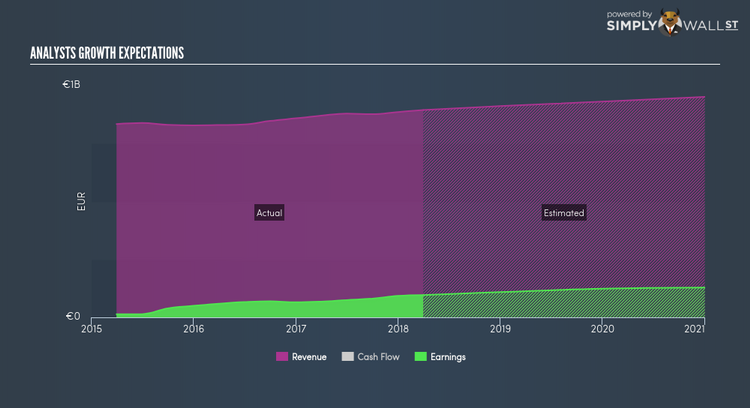DNA Oyj (HEL:DNA) Investors Are Paying Above The Intrinsic Value

In this article I am going to calculate the intrinsic value of DNA Oyj (HLSE:DNA) using the discounted cash flows (DCF) model. Anyone interested in learning a bit more about intrinsic value should have a read of the Simply Wall St analysis model. Also note that this article was written in May 2018 so be sure check the latest calculation for DNA Oyj here.
Is DNA fairly valued?
I’ve used the 2-stage growth model, which simply means we have two different periods of varying growth rates for the company’s cash flows. Generally the initial phase has higher growth rates that plateau over time. To begin, I pulled together the analyst consensus forecast of DNA’s levered free cash flow (FCF) over the next five years and discounted these values at the rate of 8.15%. When estimates weren’t available, I’ve extrapolated the average annual growth rate over the previous five years, capped at a reasonable level. This resulted in a present value of 5-year cash flow of €494.74M. Keen to know how I calculated this value? Read our detailed analysis here.
The graph above shows how DNA’s earnings are expected to move going forward, which should give you some color on DNA’s outlook. Now we need to calculate the terminal value, which is the business’s cash flow after the first stage. It’s appropriate to use the 10-year government bond rate of 2.8% as the steady growth rate, which is rightly below GDP growth, but more towards the conservative side. The present value of the terminal value after discounting it back five years is €1.27B.
The total value is the sum of cash flows for the next five years and the discounted terminal value, which results in the Total Equity Value, which in this case is €1.77B. In the final step we divide the equity value by the number of shares outstanding. This results in an intrinsic value of €13.37, which, compared to the current share price of €19.71, we see that DNA Oyj is rather overvalued and not available at a discount at this time.
Next Steps:
Whilst important, DCF calculation shouldn’t be the only metric you look at when researching a company. What is the reason for the share price to differ from the intrinsic value? For DNA, I’ve compiled three relevant factors you should further research:
Financial Health: Does DNA have a healthy balance sheet? Take a look at our free balance sheet analysis with six simple checks on key factors like leverage and risk.
Future Earnings: How does DNA’s growth rate compare to its peers and the wider market? Dig deeper into the analyst consensus number for the upcoming years by interacting with our free analyst growth expectation chart.
Other High Quality Alternatives: Are there other high quality stocks you could be holding instead of DNA? Explore our interactive list of high quality stocks to get an idea of what else is out there you may be missing!
PS. Simply Wall St does a DCF calculation for every FI stock every 6 hours, so if you want to find the intrinsic value of any other stock just search here.
To help readers see pass the short term volatility of the financial market, we aim to bring you a long-term focused research analysis purely driven by fundamental data. Note that our analysis does not factor in the latest price sensitive company announcements.
The author is an independent contributor and at the time of publication had no position in the stocks mentioned.

 Yahoo Finance
Yahoo Finance 
